
In today’s information society, with the rapid development of network technology, a variety of applications based on the Internet, especially higher education is increasingly being emphasized. This paper focuses on the idea of problem-driven and innovative iteration to build a college network Civic and political education information environment, deepen the teaching digital resources, and realize the technology-enabled system upgrading. Based on the learning behavior data, a recommendation method for college Civic and Political teaching resources based on association rules and collaborative filtering algorithms is constructed. Finally, it is verified through experiments that the method can meet the basic needs of current network Civic and Political Education in colleges and universities. The results show that the average value of each teaching effect evaluation index of network Civic and Political Education is between 2.7699~3.6623, which is obvious to improve the effect compared with the traditional Civic and Political Education mode. This adds new kinetic energy and opens a new track for the digital development of ideological and political education in colleges and universities.
In the rapid development of mobile networks today, the Internet has emerged as an integral platform for young students to learn, necessitating an innovative approach to traditional ideological and political education (IPE) methods in colleges and universities, in line with societal advancements [122]. The proliferation of diverse network media has paved a novel avenue for the innovative development of IPE in academic institutions [3].
Network information technology enhances ideological and political education (IPE) in colleges and universities, aligning with the inherent requirements of reforming the teaching mode of IPE. Consequently, it fosters novel teaching modalities, including microfilms, short videos as distinctive instructional means, and intelligent teaching software as a tool. These modalities transcend the tedious stereotypes of traditional teaching, effectively integrating classroom and extracurricular, online and offline learning, and substantially augmenting the vitality and efficacy of IPE. However, concurrently, it confronts challenges such as inadequate utilization of educational resources, uneven distribution of resource access, difficulties in promoting the new teaching mode, a surplus of underutilized educational resources, and the phenomenon of superficial adoption of technology (“old wine in new bottles”) [4-6]. To overcome these dilemmas in IPE empowered by network information technology, it is imperative to prioritize the development of intelligent infrastructure for Civic and Political Science courses, establish a foundation for the new digital teaching mode, construct network information resource platforms, and enhance the capacity of Civic and Political Science teachers [7,8].
In the context of the rapid development of network information technology, the reform and innovation of Civic and Political Science course teaching necessitates the extensive integration of mobile internet technology underpinned by advancements such as 5G, cloud computing, big data, artificial intelligence, and VR technology. Furthermore, the full utilization of intelligent teaching software is paramount. Literature [9], through an analysis of teaching experiments, underscores the necessity for student education to prioritize and balance the comprehensive development of both intellectual and moral education. In a research report on cultural ideology, the ideological and moral landscape of hip-hop elements within music education, Literature [10] highlights hip-hop education as an efficacious teaching approach in the realm of music instruction. Utilizing a semi-structured interview methodology, Literature [11] divulges the civic perceptions of secondary school history teachers in Spain and Chile, where ethical and participatory civic perspectives serve as the dominant ideology, intimately tied to their contextual experiences. Lastly, Literature [12] underscores the significance and prevalence of civic education, summarizing pertinent studies conducted in Africa. This work delves into a profound discussion on citizens’ patriotism, sense of belonging, and civic moral autonomy.
Literature [13] employs qualitative analysis methods to argue that Indonesian civic political correctness, neoliberalism, patriotism, and moralism, to varying degrees, hinder the mental health of adolescents. Literature [14] proposes an Internet of Things (IoT)-based teaching level assessment method utilizing a long short-term memory network as its core structure. Experimental teaching feedback indicates that this assessment method demonstrates higher efficiency and accurate teaching level evaluation capabilities. Literature [15] introduces an IoT-assisted interactive system (IoT-IS) to evaluate the performance of teachers and students, discovering that an intelligent learning-enabled teaching model significantly contributes to enhancing students’ performance and fostering greater concentration. Literature [16] describes the MOOC (Massive Open Online Courses) teaching format, which integrates open learning resources and offers an autonomous online learning platform. Simulation test experiments reveal that the MOOC teaching model positively motivates students and improves their learning abilities.
This paper employs the internet as a platform for distance education, examining the elemental composition, structural characteristics, and functional manifestations of the development of online Civic and Political Education (CPE) in colleges and universities. The Apriori algorithm is utilized to process students’ course selection data, which is subsequently fed into the association rule algorithm. Additionally, the Vector Space Model (VSM) is adopted for feature extraction, mapping the textual content of CPE resources into a feature vector. A metadata-based semantic lattice model is constructed from the metadata of CPE resources, and this model is then leveraged to characterize the semantics of vocabulary and resources, enabling semantic clustering of CPE resources. Finally, the key success factors for implementing online CPE in colleges and universities, as well as its applicability within the higher education sector, are rigorously validated.
The seamless integration of cutting-edge technologies, including big data, cloud computing, and blockchain, with ideological and political education (IPE) in colleges and universities has significantly accelerated the transformation and evolution towards the digitization of IPE. This integration has further propelled the high-quality development of IPE in these institutions. A forward-thinking approach, comprehensive planning, and a systematic strategy to advance the digitalization of IPE in colleges and universities is pivotal for the overall enhancement of IPE quality. Figure 1 illustrates the conceptual and pathway framework for the informatization of IPE in colleges and universities, which revolves around a problem-driven and innovative iteration mindset. This framework emphasizes the establishment of a conducive information environment and the reinforcement of two fundamental pillars: digital resources and technological infrastructure. By refining information governance and prioritizing the enhancement of digital literacy, the framework realizes technology-enabled systemic upgrading, ensuring the effectiveness and sustainability of IPE initiatives.
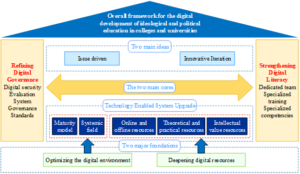
The development of informatization of ideological and political education in colleges and universities requires the integration and symbiosis of data thinking and educational value concepts, which in turn inspires the holistic creation of practice from systematic innovation in thought. Taking students as the main body, driving the resolution of contradictions around the real needs, and promoting the iterative innovation of digital transformation.
In the progression of informatization development, it is imperative to articulate the direction and objectives of transformation, while leveraging students’ needs as the primary impetus in a pragmatic approach. The objective of informatization is unambiguous: to enhance teaching efficacy, foster students’ innovative capabilities, and instill the essence of socialist core values. To this end, we engage in research, communication, and practical application to gain insights into students’ needs, aspirations, and challenges pertaining to informatization education. Subsequently, we adjust teaching content, methodologies, and resources in accordance with these needs, thereby fostering a student-centric informatization education paradigm. The principles of direction-guided and demand-driven reinforce and amplify each other, ensuring not only the achievement of informatization transformation goals and orientation but also a closer alignment with students’ needs and the realities of education. This approach ultimately enhances the relevance and efficacy of civic education.
As the influence of the internet on the learning and lifestyles of college students continues to escalate, the ideological and political education (IPE) network platform for higher education students has emerged as a pivotal component in fostering moral education within universities. Both from the perspective of keeping abreast with the development of the times and fulfilling the obligation of educating individuals, it is imperative and urgent to fortify the construction of an IPE network platform for college students, leveraging the internet as a medium to deliver comprehensive and in-depth ideological and political education. To this end, ideological and political educators in universities ought to “concentrate efforts, fortify infrastructure, elevate quality, implement dynamic management, ensure security, and foster vitality,” thereby establishing an IPE network platform that harmoniously integrates ideology, professionalism, entertainment, and service.
As higher education institutions stand at the forefront of Internet advancements, college students constitute the primary demographic of Internet users. The Internet, serving as a novel environment for ideological and political education among college students, necessitates the exploration and utilization of new media as a vehicle for instruction. This presents educators with emerging challenges of our time. In constructing a network platform for ideological and political education in colleges and universities, it is imperative to adhere to the following guiding principles:
Clear guiding ideology, the principle of accurate positioning of the network platform.
People-oriented principle, the implementation of the basic connotation of “equality, respect, development”.
The principle of relevance, the design should be aimed at the characteristics of young college students, and strive to ideological and political education theory into a vivid image of the network expression, attracting students to take the initiative to use.
the principle of management standardization, the establishment of a set of strict network information approval procedures, and make adjustments at any time, to ensure that the content published on the network platform is correct, true, and no political mistakes.
The principle of scientificity, learning and applying the latest achievements of modern scientific and technological research, and pushing ideological and political education in colleges and universities into a modernized track.
The principle of effectiveness, in specific practice, the use of scientific educational tools, and strive to minimize the time and energy, to achieve the most desirable educational results.
The workflow of the university network civic education platform, as presented in Figure 2, outlines the interaction between system administrators and students upon entry into the system. Both parties undergo identity authentication, granting them access to permissions tailored to their respective roles. The administrator, upon logging in, is tasked with managing and maintaining various components of the system, including login user accounts, the literature information database, video content repository, and examination paper archive. Within the management of examination papers, the administrator inputs parameters for paper generation, enabling the system to automatically compose test papers.
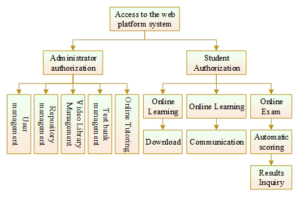
The workflow of the network civic education platform constructed in this study, as depicted in Figure 2, involves system administrators and students accessing the system through identity authentication, which grants them respective permissions. For administrators, the system enables the management and maintenance of login users, a literature information database, a video information database, and a test paper repository. Specifically, in managing test papers, administrators input parameters for paper generation, enabling the system to automatically compose exams.Students, upon entering the system, have access to two primary modes of operation: the online learning mode and the test mode. In the online learning mode, students can view and download relevant educational materials. In contrast, the test mode facilitates students to complete tests, which are automatically graded by the system upon completion and stored in the database for subsequent review by the candidates.
The continual augmentation of learning resources on the Civic and Political Education Platform in higher education institutions has indeed facilitated student access, yet it has concurrently posed numerous challenges. Notably, students confronted with an overwhelming diversity of teaching resources often struggle to accurately select those most suited to their needs. To address this issue, we propose a recommendation algorithm for college Civics teaching resources, grounded in the principles of course information and course ratings. This algorithm, illustrated in Figure 3, integrates association rule mining and collaborative filtering techniques, utilizing data from course selection and rating activities. The algorithmic framework can be broadly categorized into two phases: an offline background calculation phase and an online real-time calculation phase.
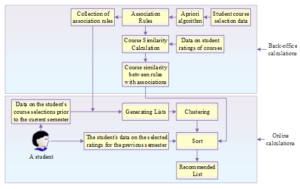
In this paper, Apriori algorithm is used to process students’ course selection data, and the output association rules are deposited into \(L\). The specific calculation process is: \[\label{GrindEQ__1_} S_{\alpha \beta } {\rm =}\frac{1}{K(O\beta )} \sum _{i=1}^{m}\frac{a_{i\alpha } a_{\alpha \beta } }{K(\mu _{i} )} , \tag{1}\] where \(O_{\beta }\) denotes the degree of teaching resource \(\beta\), i.e., the number of users who collect teaching resource \(\beta\). \(K(\mu _{i} )\) denotes the degree of user node \(i\), i.e., the number of teaching resources selected by user \(i\).
Assume a matrix of students \(X=\left[x_{1} ,x_{2} …x_{i} …x_{m-1} x_{m} \right]\), and a certain course \(y=[S(x_{1} ,y),S(x_{2} ,y),…S(x_{i} ,y)…S(x_{m-1} ,y),S(x_{m} ,y)]\) that is rated by these students. first consider the student rating values as the weights of the students’ investments, if student 1 and student 2, respectively, invested in course 1, course 2, weight 1, weight 2, weight 3, and weight 4. Assume that student 1’s resources are set to \(x\), student 2’s to \(y\), and that the weights 1 through 4 are represented by 1I, 2I, 3I, and 4I, respectively. Then course 1 can be represented as: \[\label{GrindEQ__2_} \left\{\begin{array}{l} {courses1=I_{1} *x+I_{3} *y} \\ {courses2=I_{2} *x+I_{4} *y} \end{array}\right. . \tag{2}\] Considering it as a two-dimensional vector gives: \[\label{GrindEQ__3_} CV_{(1,2)} =\frac{I_{1} +I_{3} -\left|I_{1} +I_{3} \right|}{I_{1} +I_{3} } +\frac{I_{2} +I_{2} -\left|I_{2} +I_{4} \right|}{I_{2} +I_{5} } . \tag{3}\] If the number of students becomes \(m\), rating courses \(i\), \(j\), and letting student \(x\) rate \(i\) as \(S(x,i)\) and \(j\) as \(S(x,j)\), then the similarity of \(i\), \(j\) is: \[\label{GrindEQ__4_} CV_{(i,v)} =\frac{2-\sqrt{\frac{(I_{1} -I_{3} )^{2} }{(I_{1} +I_{3} )^{2} } -\frac{(I_{2} -I_{4} )^{2} }{(I_{2} +I_{4} )^{2} } } }{2} . \tag{4}\] The similarity between courses that have association rules in \(L\) is calculated using the formula above and deposited in \(M\). As mentioned above, sparse data affects the calculation of similarity accuracy between courses, and in this paper there will be ungraded items are courses not selected by students. However, in this paper only the similarity between courses with association rules is calculated. In calculating the course similarity, this paper has defaulted to the case that these courses will be selected to calculate the student’s rating of the course content.
Cluster analysis is a pivotal technique in data analysis, which involves the statistical grouping of sample individuals or target variables based on their shared characteristics. It represents an essential approach in human behavior analysis. A commonly employed method for clustering Civic Education resources involves the similarity judgment approach. This method effectively reduces the scope of clustering, thereby enhancing the accuracy of the clustering process.
The process of clustering Civic and Political Education Resources mainly involves the extraction of semantic features, and the commonly used methods are Vector Space Model (VSM). VSM is also used here for feature extraction, which maps the textual content of a resource into a feature vector.
In this paper, TFIDF weights are used to measure the feature frequency of feature items appearing in this document, and the formula of TFIDF is as follows: \[\label{GrindEQ__5_} TFIDF(t)=TF(t,D_{i} )*\log \left(\frac{N}{DF(t)} +0.01\right) , \tag{5}\] where, \(TF\) refers to the word frequency, which indicates the frequency of occurrence of the word \(t\) in the text \(D_{i}\). \(N\) denotes the number of all documents, and \(DF\) denotes the number of documents containing feature word \(t\), i.e., the document frequency of feature word \(t\). The second part on the right side of the formula indicates the inverse document frequency of the IDF feature word.
Considering the length of the text to normalize the weights of the feature terms, the formula is as follows: \[\label{GrindEQ__6_} TFIDF(t)=\frac{TF(t,D_{i} )*\log \left(\frac{N}{DF(t)} +0.01\right)}{\sqrt{\sum _{i=1}^{m}\left[TF(t,D_{i} )*\log \left(\frac{N}{DF(t)} +0.01\right)\right] } } . \tag{6}\] Cluster analysis, a pivotal technique in data analysis, involves statistically grouping sample individuals or target variables based on their shared characteristics. In the context of Civic Education resources, clustering aims to group resources with high semantic similarity into coherent categories. The semantic lattice model presented in this paper specifically characterizes the semantic connections and distributions between words and vocabularies, facilitating the completion of semantic clustering for Civic Education resources. The effectiveness of this clustering approach is illustrated in Figure 4.Our framework revolves around the semantic grid for web-based Civic Education resources. Initially, a metadata semantic grid model is constructed utilizing the metadata of Civic Education resources. Subsequently, this semantic grid model is employed to capture the semantics of vocabulary and resources, enabling the realization of semantic clustering for Civic Education resources. This approach ensures that resources with similar meanings are grouped together, enhancing the precision and relevance of the clustering process.
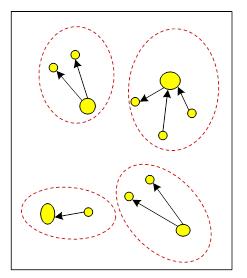
This study delves into the network ideological education framework in colleges and universities, encompassing five integral modules: informatization organization strategy, informatization management service, informatization infrastructure, informatization resource construction, and the primary driver of informatization development. A comprehensive questionnaire survey was conducted among university A, yielding a total of 100 sample data points. These data were rigorously synthesized and processed to derive the average score for each index item, subsequently enabling the assessment of the informatization development level across all modules. This methodology ensures a comprehensive and nuanced understanding of the network ideological education landscape within the institution.
The comprehensive scores for each index item within the organizational strategy module of educational informatization at University A were derived from a comprehensive questionnaire survey. The distribution of these scores, as depicted in the radar chart in Figure 5, offers valuable insights into the level of development for each index item within this module. Specifically, the scores for the index items pertaining to organizational structure (0.18), strategic planning (1.45), rules and regulations (1.71), and budget (1.64) suggest that these aspects of the college’s organizational strategy are currently in the initial to developmental stages, as per the maturity model’s criteria. Conversely, the score for the standard index item (2.03) indicates that this aspect has attained the developmental level, marking a notable achievement. This analysis underscores the need for targeted interventions to further advance the development of the remaining index items within the organizational strategy module.
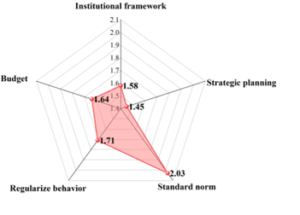
The questionnaire survey conducted at University A has yielded comprehensive scores for each index item within the management service module of education informatization. The distribution of these scores, as illustrated in Figure 6, provides a clear picture of the development levels of the various indicator items within this module. Based on the maturity model’s criteria, it can be deduced that the school administration (2.275), scientific research management (2.27), and information sharing (2.06) indicator items are currently transitioning from the developmental level to the standard level, indicating a solid foundation for further refinement. On the other hand, the indicator items pertaining to student management (3.33) and faculty teaching management (3.18) have advanced to the integration stage, marking a significant progression from the standard level towards the optimization level. This assessment underscores the university’s commitment to enhancing its management services through continuous improvement and optimization.
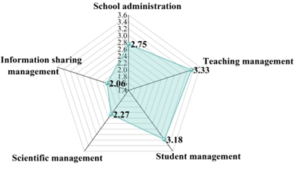
The visualization chart and data display reveal that University A’s overall informatization is currently transitioning from the developmental level to the standard level. However, a notable shortcoming lies in the relatively low level of the informatization strategic module. Consequently, University A must prioritize strategic planning to elevate its educational informatization level. The success of this endeavor is intricately linked to the support and guidance provided by school leaders. Insights gained from questionnaire surveys and interviews with these leaders indicate that, while acknowledging the potential for school informatization to enhance operational efficiency, they do not consider it a core component of the university’s development strategy. Furthermore, the university lacks clear objectives, tasks, measures, and implementation steps for informatization development within its overall strategic plan. This lack of strategic direction explains why school leaders often struggle to effectively utilize informatization tools. As the drivers and champions of school development, leaders must recognize the importance of informatization and provide both strategic guidance and encouragement. Enhancing the level of educational informatization in universities necessitates a strategic approach that addresses these shortcomings.
The factors involved in the study of online Civic Education in higher education are Performance Expectation (PE), Effort Expectation (EE), Social Influence (SI), Facilitating Condition (FC), System Quality (SQ), User Characteristics (UC), Curriculum Quality (CQ), Hedonic Motivation (HM), Habits (HA), and Intention to Use the System (ELI), and Behavior of Using the System (ELU). All the factors in the model were measured in the form of a five-point Likert scale and the questions measuring a particular variable were put together to form a group in order to minimize the level of confusion of the respondents while filling out the questionnaire.
In this paper, the analysis and processing of data collected from the questionnaire is presented in three main parts: descriptive statistics, reliability and validity analysis and hypothesis testing in the model. The main data processing method used is Structural Equation Modeling (SEM) method, and SPSS 21.0 and AMOS 21.0 software are applied to process the analysis and test. Based on the 252 valid questionnaires of this survey, the results of descriptive statistics are shown in Table 1. It can be seen that 11 variables, with mean values ranging from 2.7699 to 3.6623, indicate that 11 variables such as performance expectation and effort expectation can significantly affect the effectiveness of online Civic Education in colleges and universities.
| Variable | Min | Max | Mean | Std. Deviation |
| PE | 2.00 | 5.00 | 3.6623 | 0.7856 |
| EE | 1.00 | 5.00 | 3.4850 | 0.6136 |
| SI | 1.00 | 4.00 | 3.2089 | 0.4368 |
| FC | 2.00 | 5.00 | 3.2106 | 0.7984 |
| SQ | 1.00 | 4.00 | 2.7699 | 0.7475 |
| UC | 1.00 | 5.00 | 3.4125 | 0.4852 |
| CQ | 1.00 | 4.00 | 3.3760 | 0.5572 |
| HM | 1.00 | 5.00 | 3.7322 | 0.6847 |
| HA | 1.00 | 5.00 | 3.2431 | 0.6671 |
| ELI | 1.00 | 4.00 | 3.2383 | 0.6017 |
| ELU | 2.00 | 5.00 | 3.6295 | 0.7076 |
For the influencing factors of demographic variables on the effectiveness of online Civic Education, this paper utilizes analysis of variance (ANOVA). It mainly investigates the differences in the effects of age, gender, educational background and experience on several latent variables of performance expectations, effort expectations, social influence, facilitating conditions, system quality, user characteristics, course quality, hedonic motivation, habits, as well as the 2 dependent variables of system use intention and system use variables. The results of the ANOVA based on age, gender, educational background, and experience are shown in Table 2. The results of the ANOVA showed that the relationship between the effects of different ages and the 8 influential factors was significant. The influential relationship between different genders and 3 influential factors is significant, and the influential relationship between educational background and 5 influential factors is significant. Overall, 8 of the 11 variables in this study were supported.
| Variable | Age | Gender | Education background | Experience |
| PE | 0.325** | 0.309** | 0.203* | 0.452** |
| EE | 0.674*** | — | — | 0.550*** |
| SI | 0.181* | — | — | — |
| FC | 0.235** | 0.183* | — | — |
| SQ | — | — | — | — |
| UC | 0.304** | 0.294** | 0.144* | — |
| CQ | — | — | — | 0.318** |
| HM | 0.211** | — | 0.241** | — |
| HA | 0.188* | — | — | |
| ELI | 0.231* | — | 0.285** | 0.203** |
| ELU | — | — | 0.294** | — |
| Total number of factors | 8 | 3 | 5 | 4 |
This paper shows the application of association rules and collaborative filtering algorithms in the recommendation of education resources by systematic analysis of the informationization of education.This paper delves into the construction of an ideological and political education network platform tailored for college and university students, serving as a novel vehicle and communication channel between educators and learners. This platform transcends the conventional boundaries of time and space in ideological and political education, thereby enhancing teaching efficiency and quality. It holds significant implications for realizing genuine quality education, fostering flexible and diversified personalized learning, and nurturing competent socialist builders and successors. Empirical results underscore the efficacy of this approach, with mean values of 3.6623 and 3.4850 for performance expectation and effort expectation, respectively, indicating a notable impact on teaching effectiveness. Consequently, this paper advocates leveraging advancements in information technology and novel connectivity methods to navigate the intersection of real, digital, and virtual spaces. The aim is to strategically depict the intersections between emerging technologies and ideological-political education, presenting taught groups with more meaningful and enriching experiences. Ultimately, this endeavor endeavors to ground ideological-political education firmly within a realm of profound significance.